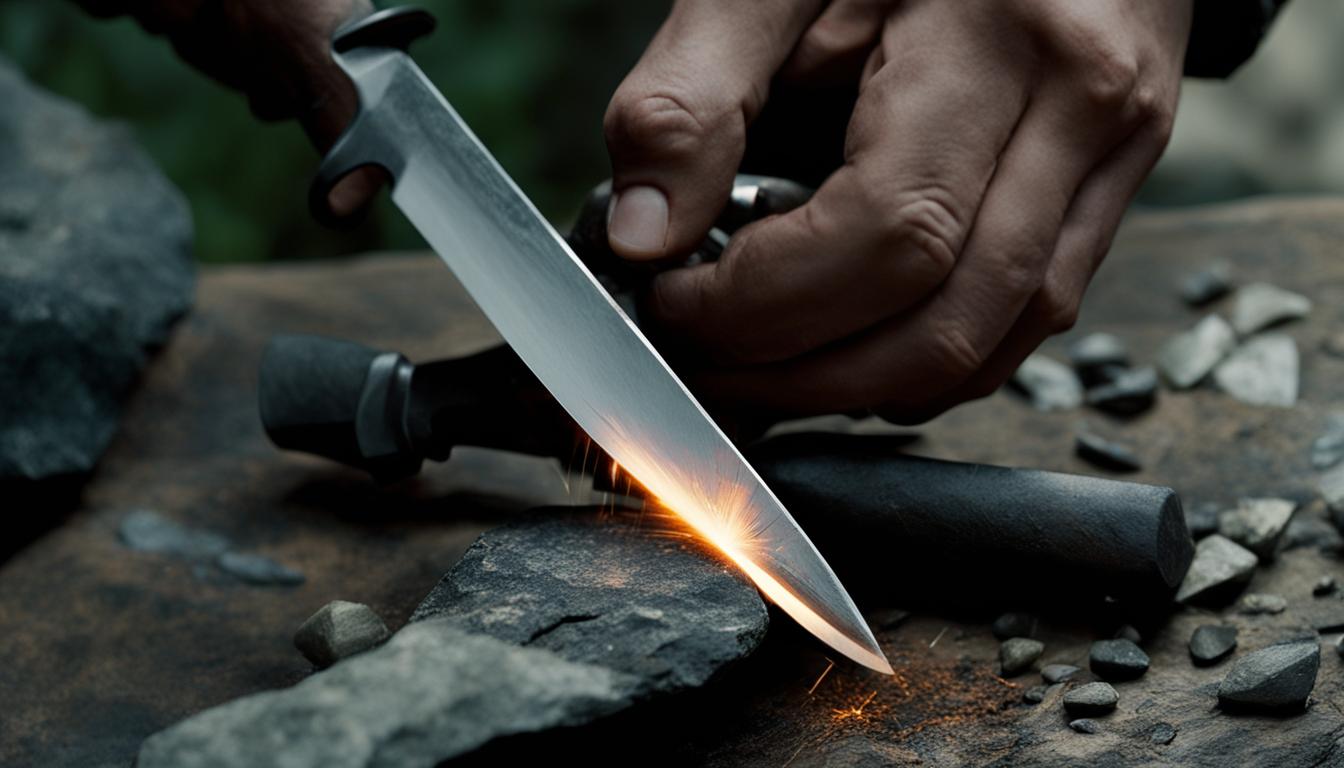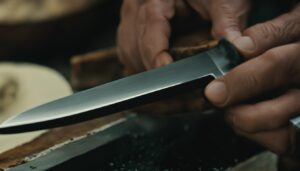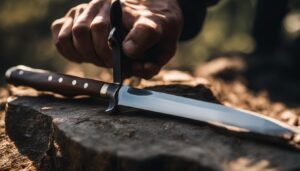Sharpening your hunting knife is crucial for any outdoor enthusiast. A dull knife can hinder your hunting experience and pose safety risks. That’s why using a whetstone is a time-tested and effective method to keep your hunting knife sharp and ready for action.
In this ultimate guide, I will provide you with detailed instructions and tips on how to sharpen your hunting knife with a whetstone. By following these techniques, you’ll be able to maintain a razor-sharp edge on your knife, ensuring optimal performance during your hunting adventures.
- Hunting knife sharpening with a whetstone is a must for outdoor enthusiasts.
- A sharp hunting knife enhances performance and safety during hunting activities.
- Using a whetstone is a traditional and effective method for sharpening hunting knives.
- Proper sharpening techniques and maintaining a consistent angle are crucial for optimal results.
- Regular maintenance and care of your hunting knife will ensure long-lasting sharpness.
Understanding the Sharpening Process
When it comes to sharpening your hunting knife, it’s crucial to understand the sharpening process and the different techniques required for various blade designs. Each type of hunting knife, from drop point to clip point, gut hook to Bowie, and skinning to serrated, has its own unique characteristics that demand specific sharpening methods.
For drop point knives with curved edges, a sweeping motion along the whetstone works best. Clip point knives, with their straight edges, benefit from even, steady strokes. Gut hook knives, which have unique shapes, require precision and attention to detail when sharpening the curved hook. Bowie knives, known for their length and curve, necessitate consistent pressure along the entire length of the blade. And for skinning knives with narrow blades, maintaining a shallow angle is key to preserving their delicate edge.
By using the appropriate sharpening tool and technique for each blade design, you can ensure a finely honed edge that will make your hunting experiences safer and more efficient. Take the time to familiarize yourself with the specific requirements of your hunting knife, and you’ll be rewarded with a sharp and reliable tool in the field.
| Blade Design | Sharpening Technique |
|---|---|
| Drop Point | Sweeping motion along the whetstone |
| Clip Point | Even, steady strokes |
| Gut Hook | Precision and attention to the curved hook |
| Bowie | Consistent pressure along the entire length |
| Skinning | Maintaining a shallow angle |
Choosing the Right Sharpening Tool
When it comes to sharpening your hunting knife, having the right tool is crucial. There are several options available, each with its own pros and cons. Let’s take a closer look at some popular sharpening tools:
Sharpening Stone
A sharpening stone, also known as a whetstone, is a traditional and versatile tool for sharpening hunting knives. It consists of a coarse and fine-grit side, allowing you to gradually refine the edge of your blade. Sharpening stones require some practice and skill to use effectively, but they provide excellent control and precision.
Honing Rod
A honing rod, also called a sharpening steel, is a long, cylindrical tool made of steel or ceramic. It is used to align the blade edge and remove small burrs or inconsistencies. Honing rods are convenient for quick touch-ups and maintenance sharpening, but they do not remove a significant amount of metal from the blade.
Electric Sharpener
If you’re looking for a fast and convenient sharpening option, an electric sharpener may be the right choice for you. Electric sharpeners feature rotating abrasive wheels that quickly grind away metal and sharpen the blade. They are easy to use and suitable for beginners, but they can be aggressive and may remove more metal than necessary.
Pull-Through Sharpener
A pull-through sharpener is a compact and user-friendly tool that consists of a V-shaped slot with built-in sharpening stones or abrasive disks. To sharpen your knife, you simply pull the blade through the slot while applying light pressure. Pull-through sharpeners are portable and easy to use, but they may not provide the same level of precision as other tools.
Guided Sharpening System
If you’re new to sharpening and want a foolproof method, a guided sharpening system can be a great investment. These systems come with adjustable angle guides and abrasive surfaces, allowing you to consistently sharpen your knife at the correct angle. They offer excellent control and are suitable for beginners and experienced users alike.
Remember, the choice of sharpening tool ultimately depends on your personal preferences, skill level, and the specific needs of your hunting knife. It’s important to consider factors such as ease of use, portability, level of control, and the amount of metal removal when selecting the right tool for your needs. With the proper tool in hand, you’ll be well-equipped to keep your hunting knife sharp and ready for your next outdoor adventure.
Preparing Your Hunting Knife for Sharpening
Before you begin sharpening your hunting knife with a whetstone, there are several important steps to take to ensure optimal results. These steps include cleaning the blade, checking for nicks and chips, determining the sharpening angle, and choosing the right sharpening method.
To start, clean the blade of your hunting knife thoroughly to remove any dirt, debris, or residue. This can be done by wiping the blade with a clean cloth or brush and using a mild detergent if necessary. Cleaning the blade will allow you to see any imperfections more clearly and prevent them from affecting the sharpening process.
Next, carefully inspect the blade for any nicks, chips, or other damage. Use your finger or a magnifying glass to feel for any rough spots along the cutting edge. If you find any imperfections, you can smooth them out using a file or sharpening stone before proceeding to sharpen the knife.
Once the blade is clean and free from any damage, it’s important to determine the correct sharpening angle. The sharpening angle refers to the angle at which the blade meets the sharpening surface. This angle can vary depending on the type of knife and the desired sharpness. You can refer to the manufacturer’s recommendations or use a sharpening guide to determine the appropriate angle for your hunting knife.
Finally, choose the right sharpening method based on your skill level and the type of knife you have. There are various methods available, including using a whetstone, honing rod, or guided sharpening system. Each method has its advantages and requires different techniques. Consider your experience and the condition of your knife when choosing the most suitable sharpening method.
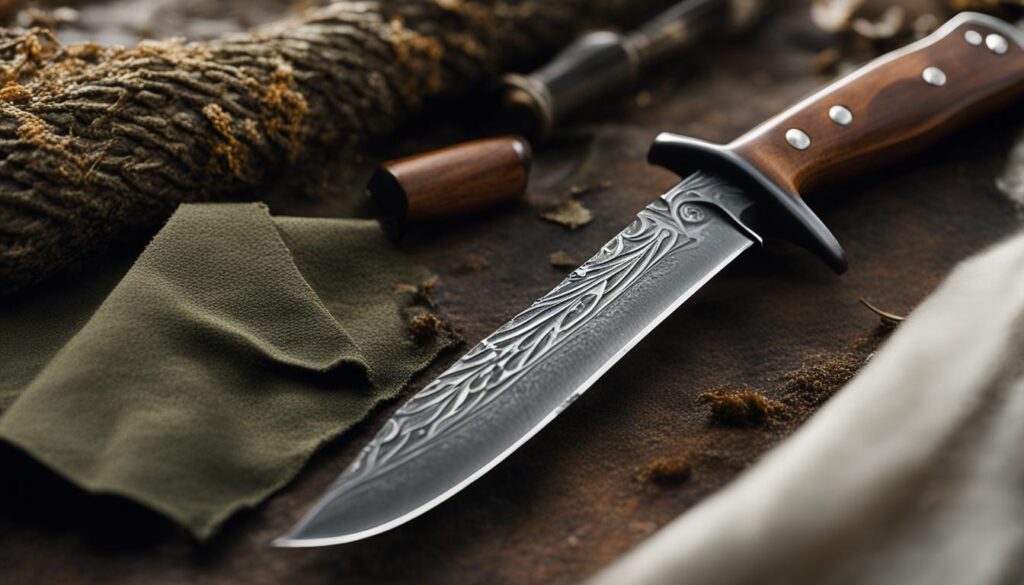
Sharpening Your Hunting Knife with a Whetstone
Sharpening your hunting knife with a whetstone is a skill that every outdoorsman should master. It allows you to maintain a sharp edge on your knife, ensuring optimal performance in the field. In this section, I will guide you through the process of sharpening your hunting knife with a whetstone, providing step-by-step instructions and valuable tips.
Step 1: Prepare the Whetstone
Before you begin sharpening, it’s important to prepare the whetstone. Start by soaking it in water for about 10 minutes, or follow the manufacturer’s instructions if using an oil stone. This helps to prevent excessive friction and ensures a smooth sharpening process.
Step 2: Set the Sharpening Angle
The next step is to set the sharpening angle. This is crucial for achieving a consistent and effective sharpening result. The ideal angle will depend on the type of knife you have, but a common angle for hunting knives is around 20 degrees. Use a sharpening guide or visually estimate the angle by aligning the blade with the stone.
Step 3: Sharpen the Blade
Now it’s time to start sharpening the blade. Hold the whetstone securely on a flat surface, and with one hand on the handle and the other on the blade, position the knife at the chosen sharpening angle. Apply light pressure and move the blade back and forth across the stone in a sweeping motion, covering the entire length of the blade. Repeat this process on both sides of the blade, alternating the strokes to ensure even sharpening.
Step 4: Remove Burrs and Polish the Edge
After several passes on each side, check for burrs or rough spots on the blade edge. Use a honing rod at a slightly steeper angle to gently remove any burrs that may have formed. Once the burrs are removed, it’s time to polish the edge. Repeat the sharpening process with lighter pressure and fewer strokes to achieve a finer edge. This will enhance the knife’s cutting performance and make it razor-sharp.
Remember to clean the blade thoroughly after sharpening and apply a light coating of oil to prevent rust. With practice and patience, you will become proficient in sharpening your hunting knife with a whetstone, ensuring that it remains sharp and ready for your next outdoor adventure.
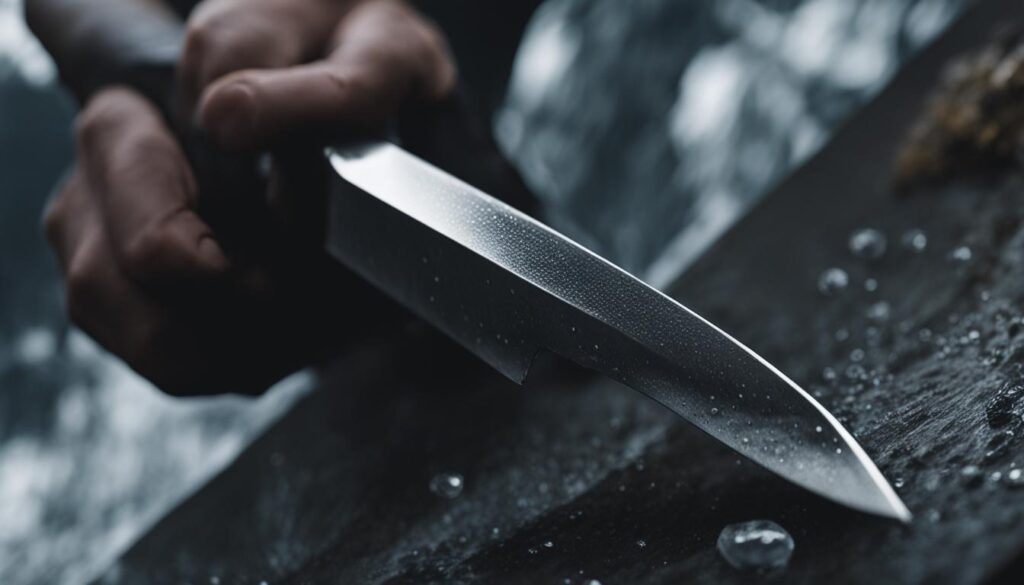

Conclusion
Sharpening your hunting knife with a whetstone is an essential skill that every outdoorsman should possess. By understanding the sharpening process, choosing the right tool, and properly caring for your knife, you can ensure that it remains sharp and performs at its best.
To maintain the sharpness of your hunting knife, regular sharpening is crucial. Using a whetstone allows you to achieve a precise edge and restore the blade’s cutting ability. Remember to maintain a consistent sharpening angle and apply light pressure when working the blade against the stone.
Proper care and maintenance of your hunting knife go beyond sharpening. Cleaning the blade, checking for nicks or chips, and removing burrs are all essential steps in preserving its longevity. Additionally, applying a light coating of oil after sharpening can help prevent rust and corrosion.
By following the techniques and tips outlined in this guide, you can ensure that your hunting knife remains sharp for extended periods, enabling optimal performance in the field. Practice regularly, experiment with different techniques, and find the sharpening method that works best for you to keep your hunting knife in top shape.
FAQ
What is the best method for sharpening a hunting knife?
Using a whetstone is a traditional and effective method for sharpening hunting knives.
What are the different types of hunting knife blade designs?
Drop point, clip point, gut hook, Bowie, and skinning knives have varying blade designs.
What are the different types of sharpening tools available for hunting knives?
Sharpening stones (whetstones), honing rods, electric sharpeners, pull-through sharpeners, and guided sharpening systems are some options.
How should I prepare my hunting knife before sharpening?
Clean the blade, check for damage, determine the sharpening angle, and choose the appropriate sharpening method.
How do I sharpen my hunting knife with a whetstone?
Hold the whetstone securely, place the knife blade at the desired angle, apply light pressure, and move the blade back and forth along the stone. Use a honing rod to remove burrs.
Why is it important to maintain a consistent angle while sharpening?
Maintaining a consistent angle ensures an even and effective sharpening process.
How often should I sharpen my hunting knife?
The frequency of sharpening depends on usage, but it’s recommended to regularly check and sharpen your knife to maintain optimal performance.
Can I use alternative sharpening methods instead of a whetstone?
Yes, there are various sharpening tools available, but using a whetstone is a popular and reliable method for sharpening hunting knives.
